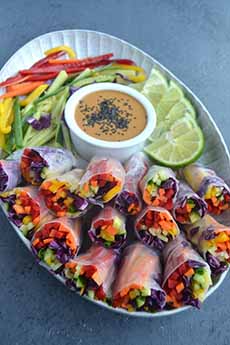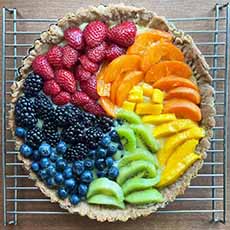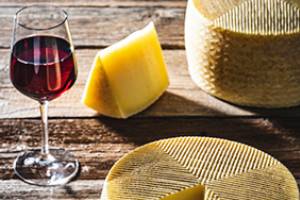|

[1] Rainbow tacos. Pick your veggie colors from this list (photo © Maria And Ricardo’s).

[2] We also made a rainbow salad for lunch (photo © Nadine Primeau | Unsplash).

[3] Rainbow pasta. Here’s the recipe (photo © Cool Mom Eats).

[4] Rainbow spring rolls. Here’s the recipe (photo © Nutritionist Reviews).

[5] Time for dessert: rainbow sherbet. Here’s the recipe (photo © Dinner Then Dessert).

[6] Or if you prefer, a rainbow fruit tart. Here’s the recipe (photo © Ugly Duckling Bakery).
|
|
We did not find a rainbow today, National Find A Rainbow Day. It was a dry, cloudy day, lacking the water vapor/droplets and sunlight required to create a rainbow.
But we did have a rainbow breakfast taco (photo #1), thanks to Maria and Ricardo, two cousins from Mexico who brought tortillas to Boston in the 1980s.
We found the idea on their Instagram page.
Since we first saw their rainbow tacos, we’ve been making them regularly. Today, National Rainbow Day, is certainly one of those days.
It’s easy to decide what rainbow colors to put in the taco (or burrito or sandwich).
We just head to our article, Eat The Rainbow, which lists every veggie and fruit by color group: green, orange, purple, blue, yellow, and white.
We included scrambled eggs, which counted as the yellow color.
There are many more rainbow dishes to make, from pizza to sushi to desserts galore. And more rainbow holidays to celebrate, below.
If you want to find a rainbow in a hurry, head to Hawaii, “The Rainbow Capitol of the World.” Here’s more about it.
THE “HISTORY” OF THE RAINBOW
We learned in 8th grade science class that the colors of the rainbow were, in order of their place on the spectrum, red, orange, yellow, green, blue, indigo and violet (ROYGBIV). The colors are the result of light being split into different wavelengths. Red is the longest, violet the shortest.
These were the original colors described by Sir Isaac Newton. There are far more, because a rainbow is actually made up of a myriad of individual spectral colors that overlap and mix.
Modern scientists who study the phenomena of rainbows—the meteorologists, atmospheric physicists, optical physicists, and spectroscopists—have dropped the “I,” combining indigo with the blue and violet spectra.
But at the beginning, there were the philosophers†.
In fact, the first writings about rainbows come from the Greek philosopher Aristotle, who mused about their colors as far back as 350 B.C.E. He recognized that rainbows involved the reflection of light in water droplets.
350-330 B.C.E.: Aristotle writes about rainbows in his treatise “Meteorologica” (Meteorology). He discusses the physical nature of rainbows, their shape and formation, the colors visible in rainbows and their order, and the conditions needed for rainbows to appear.
65 C.E., The Roman philosopher Seneca the Younger picked up on Aristotle’s ideas and added his own in his book, Naturales Quaestiones. He predicted the prism effect that was established by Sir Isaac Newton centuries later.
1304: Theodoric of Freiberg demonstrated how light is refracted and reflected inside raindrops using glass spheres filled with water.
1637: René Descartes calculated the path of light through a raindrop and explained the primary rainbow.
1666*: Isaac Newton discovered through his prism experiments that white light contains all colors of the spectrum. This finally explained how rainbows were created.
1800s: Scientists discovered ultraviolet and infrared light beyond the visible spectrum.
Modern physics now explains rainbows as the result of light being refracted, reflected, and dispersed within water droplets, creating its arc of colors.
In the process, modern definitions of the spectrum of visible light have come to exclude indigo as a primary spectral color, merging it into the ranges of shades of blue and violet.
Thus, most modern physics textbooks, scientific literature, and educational materials now use the six-color model (ROYGBV).

[7] Contemplation of rainbows began with Aristotle, who was the first to write about them in a scientific manner (photo © Look Up Look Down Photography | Unsplash).
RAINBOW HOLIDAYS
April 3: National Find a Rainbow Day (celebrate their beauty and the science behind rainbows)
June: Pride Month (coincides with the anniversary of the 1969 Stonewall riots)
June 28: Christopher Street Day (commemorates the Stonewall Riots)
August 28: Rainbow Bridge Remembrance Day (remembers beloved pets who have passed away)
October 22: National Color Day (focuses on the impact color has on each of us)
________________
*When Newton first published his work on the spectrum in 1672 in the Philosophical Transactions of the Royal Society—six years after his discovery in 1666—he initially distinguished five primary colors: red, yellow, green, blue, and violet (or purple). However, when he published his comprehensive work “Opticks” in 1704—another 22 years later—he had expanded his model to seven colors: red, orange, yellow, green, blue, indigo, and violet (the familiar ROYGBIV).
†Science did not appear as a separate field until the Scientific Revolution, 1500-1700.
|









